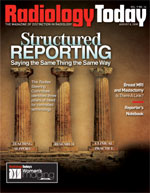
August 11, 2008
Seven Steps to Improving Radiologist Dictation
By Beverly Brooks
Radiology Today
Vol. 9 No. 16 P. 9
Today’s imaging professionals are attuned to quality in their day-to-day operations. Still, many of them are not doing their part to ensure the quality of transcribed documents. Accurately transcribed documents can be critical in the legal arena, and many can attest to the trouble an incorrect report can cause in the courtroom.
Here are some simple steps dictating radiologists can follow to ensure that a document is accurate:
1. Dictate in a quiet environment. My company receives many audio files where there is “group participation,” such as chatting nearby or a patient or family member interrupting and asking questions. Driving down the freeway with the radio blasting and the top down is not an ideal environment either. Believe it or not, physicians have dictated while using the toilet, playing with their children, attending parties, or arguing with their spouses. Finding a quiet spot will also help a dictator’s concentration and result in a more accurate document, as well as alleviate any possible HIPAA violations.
2. Speak clearly and at a normal cadence. “Speed talking” does not save any money and will result in a report with errors and blanks. We have transcribed for a physician who took extreme pride in being able to dictate notes in the time it took him to walk from one patient’s room to another—about 20 seconds. As a result, there were never any documents delivered to him without blanks. The resulting backlog of edits and corrections caused his reports to be consistently late, likely causing problems with coding and billing.
3. Don’t add to the background noise. Even when dictating from a quiet spot, many dictators will create background noise—playing a radio, tapping a pen or fingers on a tabletop, or shuffling papers. These noises create even more difficulty for the transcriptionist when the dictator is using a speakerphone.
4. Spell out names and give complete information. If you provide transcription with a daily schedule, you probably don’t need to spell patient names, but you may want a copy of the report to be sent to a referring physician, billing office, or other facility. A transcriptionist may have to stop transcribing and research the name and contact information. There are also occasions when a dictator will say, “Send a copy to Dr. Smith,” with no other identifying factors. To speed things along, give the first and last names of those who should receive a copy of the report and, if known, the city and state or any information that will cut down on the guesswork.
5. Provide the “normals.” Radiology reports frequently contain routine or normal findings. You can save dictation time and reduce the likelihood of errors by providing a “normal.” The transcriptionist can then refer to the normal text for each normal and substitute or add the current patient’s information. Additionally, samples of previously transcribed work (with patient information removed) are valuable to a transcriptionist to become familiar with formatting, as well as a dictator’s normal style.
6. Dictate as soon as possible following the patient encounter.
7. Document completed dictation. When using a handheld device and electronic transmission of the audio files, have some process in place that will document what and when files were uploaded. If you utilize tapes, use a numbering system and checklist to track the tape’s progress through the transcription process.
Some radiology organizations utilizing platforms that accommodate telephone calls have a methodology for confirming that an audio file has been accepted into the system, usually a confirmation number. By recording this number, an audio file can be tracked within the system.
A perfectly dictated and typed document requires a partnership between the dictating radiologist and the transcriptionist. The most important key to a successful partnership is communication. By promptly addressing issues or concerns, a solution is usually readily obtainable.
— Beverly Brooks is the director of operations at Health Data Services, LLC in Little Rock, Ark.

